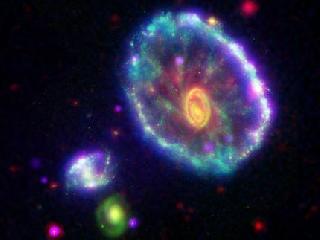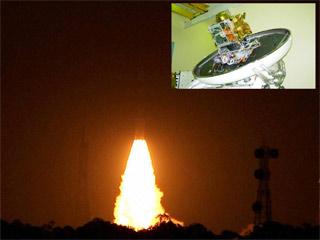
This image of the Cartwheel galaxy shows a rainbow of multi-wavelength observations from NASA missions, including the Galaxy Evolution Explorer (blue), the Hubble Space Telescope (green), the Spitzer Space Telescope (red) and the Chandra X-ray Observatory (purple). Photo: NASA/JPL-Caltech.
WASHINGTON (BNS): NASA has turned off its Galaxy Evolution Explorer (GALEX) after a decade of operations in which the venerable space telescope used its ultraviolet vision to study hundreds of millions of galaxies across 10 billion years of cosmic time.
"GALEX is a remarkable accomplishment," Jeff Hayes, NASA's GALEX programme executive in Washington, was quoted as saying in the NASA news release.
"This small Explorer mission has mapped and studied galaxies in the ultraviolet, light we cannot see with our own eyes, across most of the sky," he added.
Operators at Orbital Sciences Corporation in Dulles, Virginia, sent the signal to decommission GALEX at 3:09 p.m. EDT Friday, June 28.
The spacecraft will remain in orbit for at least 65 years, then fall to Earth and burn up re-entering the atmosphere. GALEX met its prime objectives and its mission was extended three times before NASA decided to end it.
Highlights from the mission's decade of sky scans include:
(i) The discovery of a gargantuan comet-like tail behind a speeding star called Mira.
(ii) Catching a black hole "red-handed" as it munched on a star.
(iii) Finding giant rings of new stars around old, dead galaxies.
(iv) Independently confirming the nature of dark energy.
(v) The discovery of a missing link in galaxy evolution - the teenage galaxies transitioning from young to old.
The mission also captured a dazzling collection of snapshots, showing everything from ghostly nebulas to a spiral galaxy with huge, spidery arms, according to the news report.
In a first-of-a-kind move for NASA, the agency in May 2012 loaned GALEX to Caltech, which used private funds to continue operating the satellite while NASA retained ownership.
Since then, investigators from around the world have used GALEX to study everything from stars in our own Milky Way galaxy to hundreds of thousands of galaxies 5 billion light-years away.
In the space telescope's last year, it scanned across large patches of sky, including the bustling, bright center of our Milky Way.
Data from the last year of the mission will be made public in the coming year.
"GALEX, the mission, may be over, but its science discoveries will keep on going," said Kerry Erickson, the mission's project manager at NASA's Jet Propulsion Laboratory (JPL) in Pasadena, California.
The telescope spent time staring at some areas of the sky exploded stars, called supernovae, and monitoring how objects, such as the centers of active galaxies, change over time. GALEX also scanned the sky for massive, feeding black holes and shock waves from early supernova explosions.
 Previous Article
Previous Article Next Article
Next Article












The Indian Air Force, in its flight trials evaluation report submitted before the Defence Ministry l..
view articleAn insight into the Medium Multi-Role Combat Aircraft competition...
view articleSky enthusiasts can now spot the International Space Station (ISS) commanded by Indian-American astr..
view article